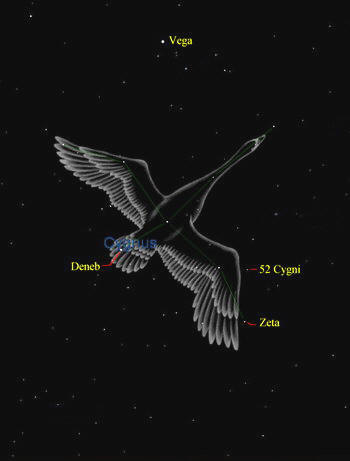Finding The Veil Nebula:
The easiest starting point to find the Veil Nebula is the relatively faint naked eye star 52 Cygni. Note that this star is located along the leading edge of the swan's wing on the side of the swan opposite the bright star Vega. It is the very bright star in the image above. This western part of the Veil Nebula, the part of the nebula shown above, is harder to see than the eastern side of the loop, so try finding the eastern side first. The eastern part of the loop goes under the name of NGC 6992 and NGC 6995. The binocular/finder chart below shows the position of the eastern side of the loop. You can click on the chart for a printable black-stars-on-white-background finder chart. Small rich field telescopes like the Orion Star Blast or the Edmund Astroscan work well for spotting the nebulosity. Nebula filters also help. With my Televue 85mm telescope (about 3 and 3/8 inch aperture) I can just make out the nebula without the filter, but it's easier to see with the filter. You can try either an OIII filter or a standard broadband light pollution filter. Again, you won't see color, just a faint glow. Be sure to use averted vision, looking to one side of the nebula's position. If you're under truly dark skies, try spotting the eastern part of the loop (NGC 6992/5) with binoculars. It will appear very much like the chart below, though the contrast will be lower. The best way to see it is to try multiple times until you encounter exceptional conditions. Use less than exceptional nights to memorize the star field. As is true with most deep sky objects, it is extremely important to have clear, dark skies.
|
|||||||||||||||||||||||


